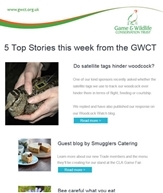 by Andrew Gilruth, GWCT Director of Communications
by Andrew Gilruth, GWCT Director of Communications
If you wish to review the environmental impacts of any land use, you must present balanced arguments and ensure facts quoted from other sources are used appropriately. This week staff at the RSPB had their view on grouse shooting published – it’s a revealing read.
The GWCT viewpoint on grouse shooting
Grouse moors, just like other land uses, such as forestry or livestock farming, are a valuable component part of a sustainable and diverse future for our uplands. All land uses should be assessed to demonstrate the benefits they provide and where any trade-offs are. Farming, for instance…
In a global context, heather moorland of the sort maintained by grouse shooting is one of the rarest habitat types and enjoys some of the highest conservation designations. Many of these moors were not designated Sites of Special Scientific Interest (SSSIs) in spite of being grouse moors, but because they were grouse moors.
There is good evidence that they are current and future refuges for wildlife in our country. This is illustrated by the fact that curlew, lapwing, black grouse and mountain hare still thrive on grouse moors while facing declines elsewhere.
There is no question that well-conducted management for grouse shooting can be a force for good in the uplands. Its demise would result in a loss of landscape value, rare biodiversity, and income and cultural value for many rural communities.
Grouse moors – the conservation case
The consequences of failing to recognise and encourage this force for good and work with farmers and gamekeepers is nowhere better illustrated than in the uplands of Wales. These once supported the most productive grouse moors in the UK as well as abundant populations of other birds.
However, since the Second World War almost half of the heather cover in Wales has been lost. Since the 1990s, owing to disease, overgrazing and, from the moor owners’ perspective, a lack of support from conservation agencies, grouse management has been all but abandoned and our upland bird populations have crashed.
This was studied by the GWCT in the Berwyn Special Protection Area (SPA) in North Wales. The results showed that between 1983 and 2002, red grouse declined by 54 per cent. Over the same period lapwing became extinct, golden plover declined from ten birds to one, and curlew declined by 79 per cent. Today, over 75 per cent of the entire Welsh black grouse population exists on the one remaining keepered Berwyn moor.
Alarmingly, we see a similar decline in upland areas actively managed for red grouse in southwest Scotland. This abandonment of sporting management threatens the rich tapestry that is the Scottish countryside.
Across the UK, there is a strong correlation between grouse moor management and the abundance and productivity of species such as lapwing, curlew and golden plover, which are otherwise increasingly rare. A scientific study by the GWCT, published in the Journal of Applied Ecology, identifies that the control of predators such as foxes and crows, carried out to protect red grouse, can benefit one of our most striking birds of prey – the hen harrier.
The essential driver
Which brings us back to the grouse. Like it or loathe it, red grouse shooting generates on average £30 million to the Scottish economy alone. The management of grouse moors (heather burning, legal predator control) hugely benefits our diverse yet fragile wildlife. And most of this management is funded through the private investment of landowners.
Given the measurable economic and biodiversity benefits that grouse management brings, many moor owners find it difficult to understand the negative attitude towards traditional moorland management.
Grouse moor management isn’t perfect. But we, as a nation, should embrace the best of grouse management and the private investment that supports it as a positive contribution to biodiversity, and celebrate the fact that there are good community, economic and environmental reasons to protect our heather hills.
Any land uses can be improved
We recognise that there is always room for improvement in any land use. The Game & Wildlife Conservation Trust has drawn together its views on many of the key upland issues in a single document, which we update as new science informs us and best practice evolves. We look forward to contributing to the ongoing discussion.
 Free weekly newsletter
Free weekly newsletter
Stay updated on this story and get all the latest GWCT blog updates and news delivered straight to your inbox each Tuesday.
Sign up FREE to the Weekly GWCT Newsletter >